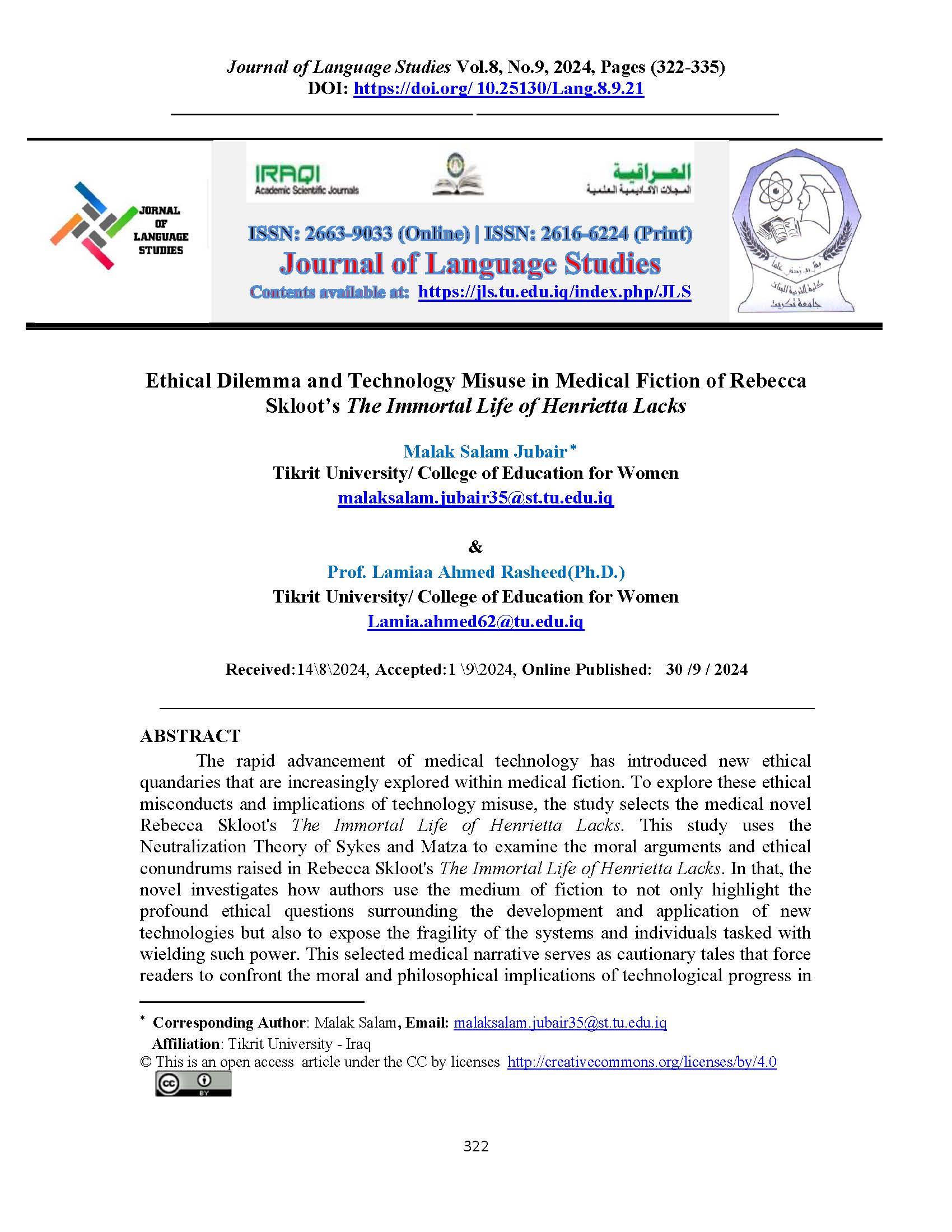Ethical Dilemma and Technology Misuse in Medical Fiction of Rebecca Skloot’s The Immortal Life of Henrietta Lacks
DOI:
https://doi.org/10.25130/Lang.8.9.21Keywords:
Ethical Dilemma, Medical Fiction, Rebecca Skloot's The Immortal Life of Henrietta Lacks, Neutralization TheoryAbstract
The rapid advancement of medical technology has introduced new ethical quandaries that are increasingly explored within medical fiction. To explore these ethical misconducts and implications of technology misuse, the study selects the medical novel Rebecca Skloot's The Immortal Life of Henrietta Lacks. This study uses the Neutralization Theory of Sykes and Matza to examine the moral arguments and ethical conundrums raised in Rebecca Skloot's The Immortal Life of Henrietta Lacks. In that, the novel investigates how authors use the medium of fiction to not only highlight the profound ethical questions surrounding the development and application of new technologies but also to expose the fragility of the systems and individuals tasked with wielding such power. This selected medical narrative serves as cautionary tales that force readers to confront the moral and philosophical implications of technological progress in the medical field, calling doctors to consider the delicate balance between scientific advancement and preserving human dignity, autonomy, and the sanctity of life.
References
Andrade, G. (2019). Medical ethics and the trolley problem. Journal of Medical
Ethics and History of Medicine, 12,
https://www.ncbi.nlm.nih.gov/pmc/articles/PMC6642460/.
Bankowski, Z. (1989). Ethics and health. World health, 17 (4), 146-149.
Borham-Puyal, M. (2023). Nurses, mothers, sisters: Relational resilience and healing vulnerability in Emma Donoghue’s The Wonder and The Pull of the Stars. World Literature Studies, 15(2), 31-43.
Charon, R. (2000). Medicine, the novel, and the passage of time. Annals of Internal Medicine, 132(1), 63–68.
Davies, H. (2004). Can Mary Shelley's Frankenstein be read as an early research ethics text? Medical Humanities, 30(1), 32–35.
Fangerau, H. M. (2006). The novel Arrowsmith, Paul de Kruif (1890–1971) and Jacques Loeb (1859–1924): a literary portrait of “medical science”. Medical Humanities, 32(2), 82-87.
Hart, G. (1965). Asclepius, God of Medicine. Canadian Medical Association Journal. 92 (5): 232–236.
Humbyrd, C. J. (2021). Virtue Ethics in a Value-Driven World: Trolley
Troubles. Clinical Orthopaedics and Related Research®, 479(4), 669-670.
McKibbin, R. (2008). Politics and the medical hero: AJ Cronin's The Citadel. The English Historical Review, 123(502), 651–678.
McKinstry, C. (2018). The HIPAA Privacy Rule: Flawed Privacy Exposed When Compared with the European Union's General Data Protection Regulation. Journal of Health Care Finance, 45 (1), 1-32
Norris, T. D. (1976). An Empirical Evaluation Of Neutralization Theory And Its Relation To Self-Reported Juvenile Delinquency. Oklahoma State University.
Rasheed, L. A. (2024). The portrayal of human chaotic behaviors as exemplified in Chuck Palahniuk’s Choke. Journal of Language Studies, 8(6), 67-76. https://doi.org/10.25130/Lang.8.6.4
Rousseau, G. S. (1981). Literature and medicine: the state of the field. Isis, 72(3), 406-424.
Shawawreh, A., & Bani-Khair, B. (2022). Medical Ethics and Women's Role in Robin Cook's Coma and Fatal Cure. Technium Soc. Sci. J., 37, 492.
Shoemaker, D. (2010). Theories of Delinquency: An Examination of Explanations of Delinquent Behavior. Oxford New York: Oxford University Press
Skloot, R. (2010). The Immortal Life of Henrietta Lacks. New York Times
Sykes, G. M., & Matza, D. (1957). Techniques of Neutralization: A Theory of Delinquency. American Sociological Review, 22(6), 664–670. https://doi.org/10.2307/2089195
Zinner, S. E. (2022). A Novel Approach to Public Health Crises Using Narrative Ethics. In Narrative Ethics in Public Health: The Value of Stories (pp. 181-192). Cham: Springer International Publishing.

